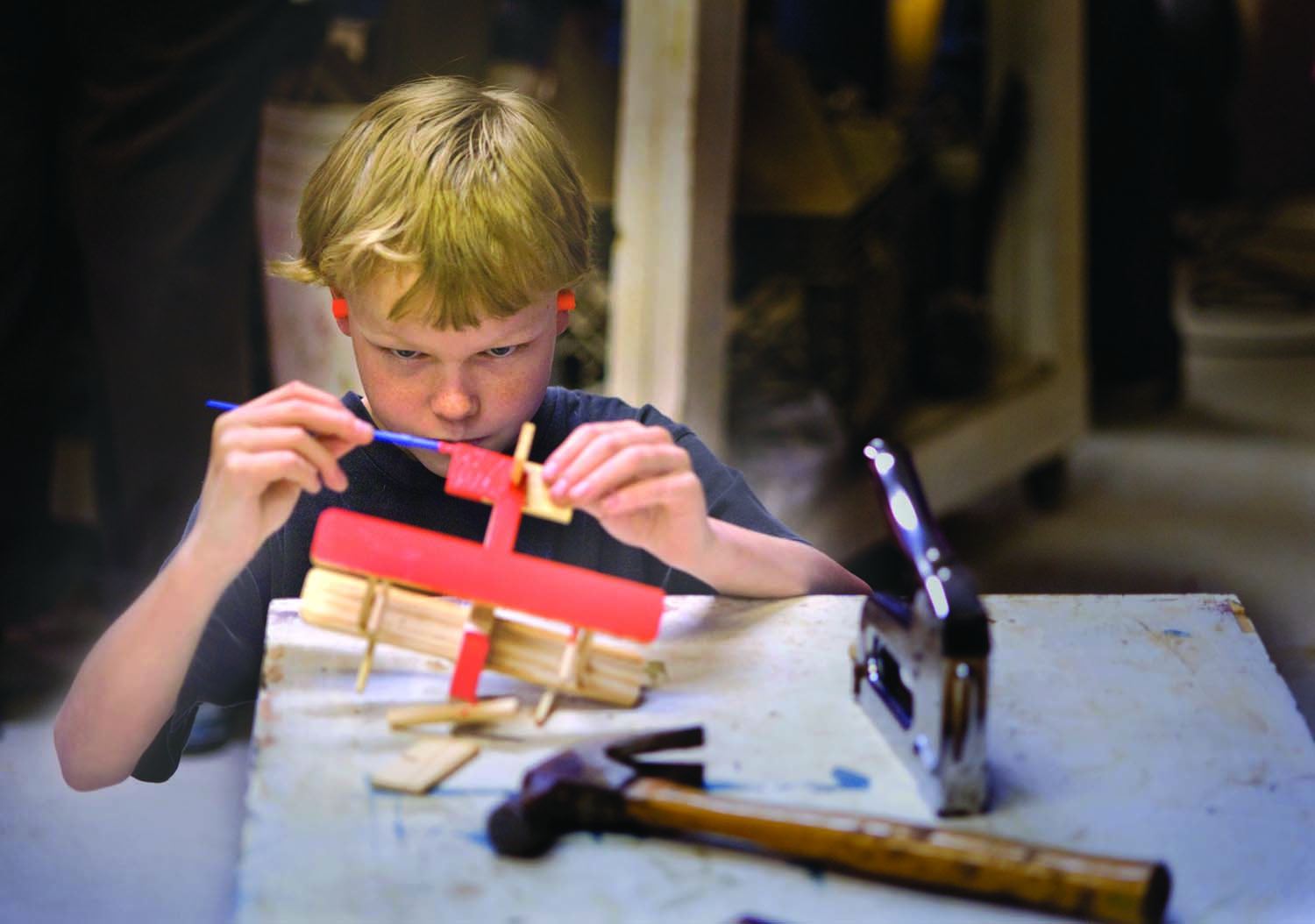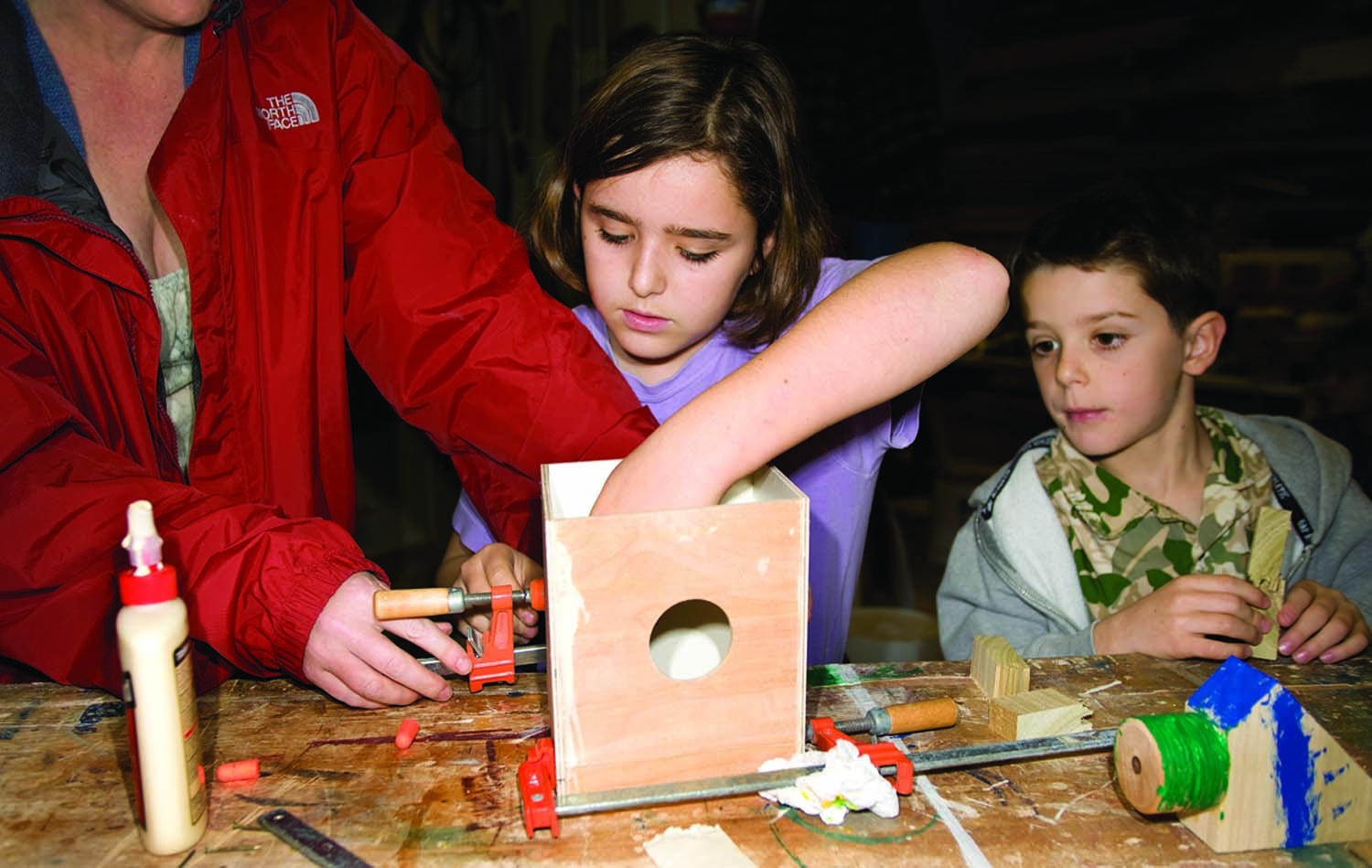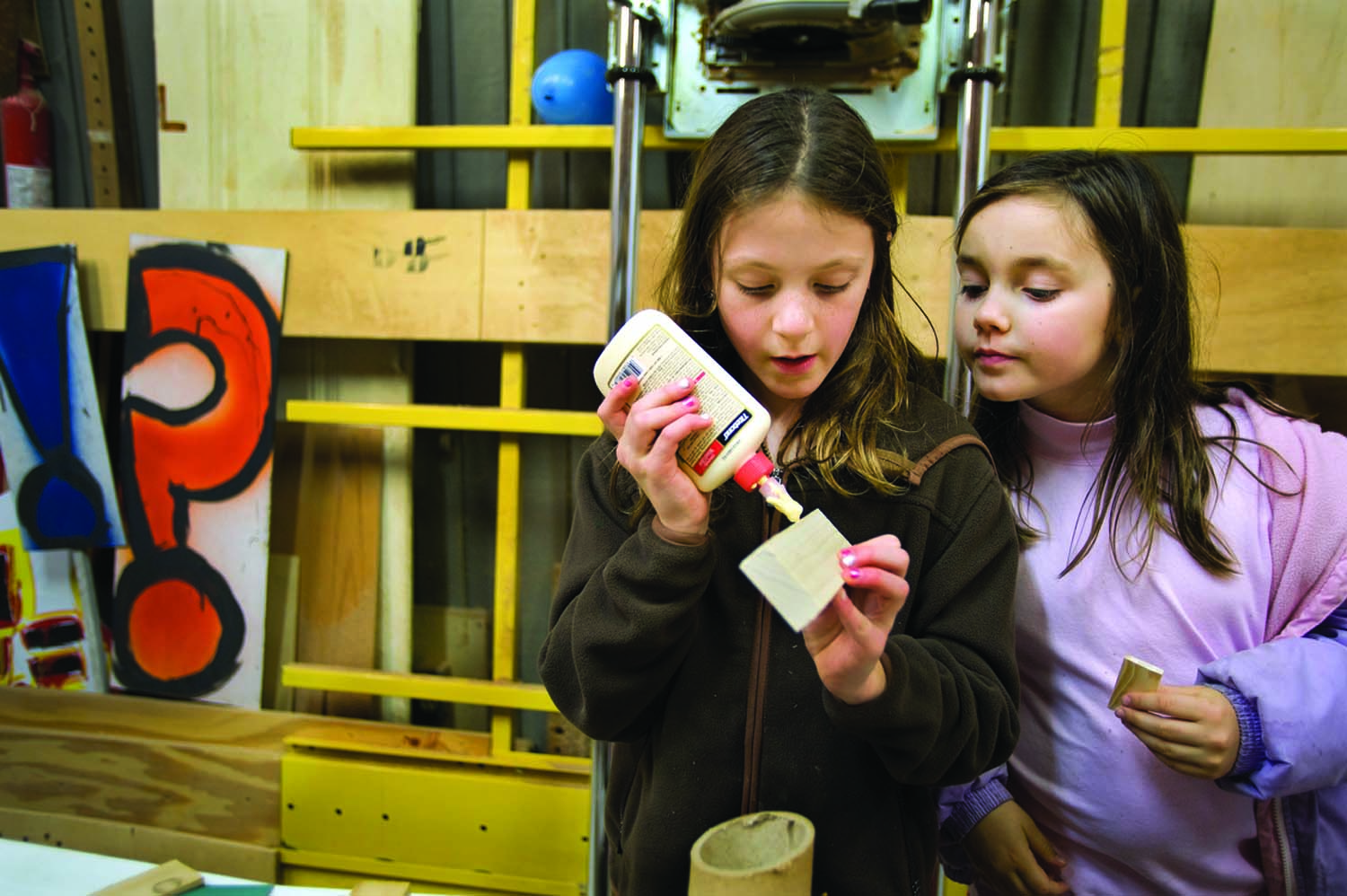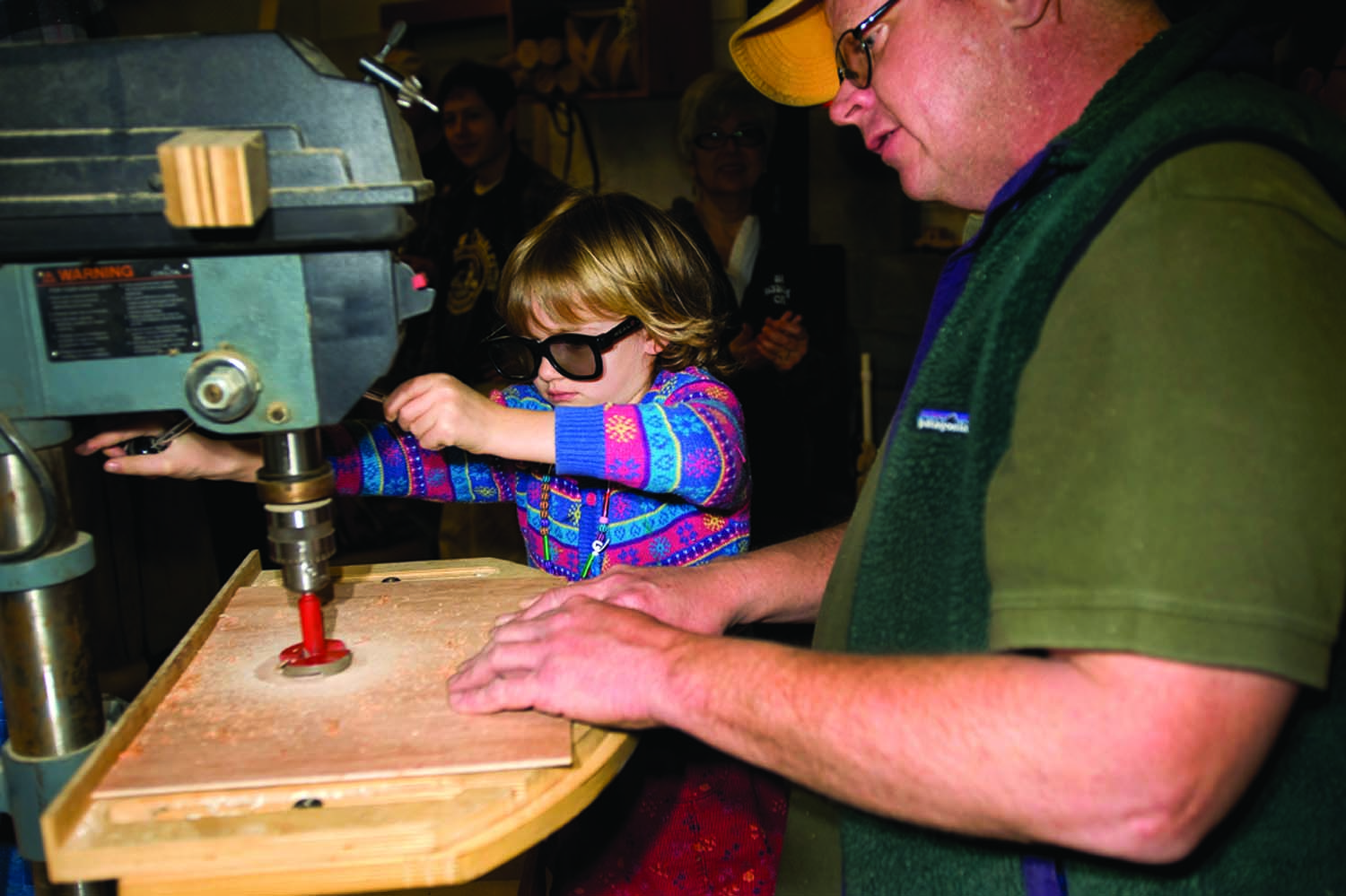We may receive a commission when you use our affiliate links. However, this does not impact our recommendations.

Concentration. Elvin’s earplugs are, according to his father, meant to block out the sound of the other children as he concentrates on producing the perfect paint job for his plane project.
Want to take up woodworking with your kids, but find it difficult to keep them in the shop? I share this desire and dilemma. I sheepishly admit that the difficulties arise from my needs and notions, not those of my son. He is, of course, perfect in every way.
I believe that all of us old-fart woodworkers need to give up our foolish notions of design, technique, function and even completion if we are to encourage our kids to join us in our ligneous endeavors.
I learned quickly with my son that allowing him to follow his muse was utmost. It also took the pressure off me. He happily does as he pleases and I get to look brilliant with almost no effort. My son, Elvin, and I have clocked a gazillion hours (his count – it has only felt like a couple zillion to me) working on countless projects in my shop. And, I can honestly say that I have absolutely no idea what many of our creations are. They are of the highest caliber, however, and are of maximum coolness, according to Elvin.
10 Things to Consider

Little brother. Lucas looks on as his sister, Gabriela, shows him how it’s done.
1. Safety! My No. 1 rule for young visitors to the shop is: DON’T TOUCH ANYTHING!!! Everything is plugged in and everything is dangerous. I tell them, “Please ask; I’ll show you how anything works.” Often this means tearing down the machine a bit, so don’t make this promise if you won’t follow through.
2. Safety equipment. Kids are often interested in a machine until it makes a really “BIG” noise – then they are turned off. Even though the young ones will never touch a piece of equipment, the proper safety gear is essential. Get them their own goggles, hearing and dust protection – not the play stuff. They know the difference. Gearing up is half the fun. They feel cool and grown up. There is also nothing cuter than a little one in full safety regalia. Keep your camera handy. And set a good example by wearing your own safety equipment.
3. Plane truth. Make lots of long, curly, shavings – even if you don’t really need to.
4. Time. A child’s attention span is short (use a dial caliper to measure it, you’ll see what I mean). At first, forget making anything that takes more than a few steps. I remember trying to get my boy to hurry up saying, “ We’ve only got five more minutes!” He looked up with a smile and said, “Wow, Poppa! That’s a really long time!”
Either have lots of ready-made parts on hand, or be prepared to work fast. You’ll be amazed at what a 2×4 and some wooden wheels can accomplish. Their imaginations supply the details.
5. Letting go. If you think their attention span is short, wait until you see how long they can focus on one idea. (Keep a magnifying glass on hand to read the dial on those calipers.) If you want to keep them coming back, let them decide what to build. Let go of the need to know what it is you are making. The end result is not important. Keep the scrap bin full.
6. Molecular bonding strips. A “fasten- ating” thing. After the cutting is done, let the child do as much of the assembly work as possible. Kids are naturals at putting things together, if not necessarily in the manner adults might choose. Leave cutting dovetails for another day. I once saw on the bulletin board in the hallway of my son’s preschool, that the teachers had placed Thanksgiving lists of things the children were thankful for. Most of the responses were predictable: Mommy, daddy, gramma and grampa, my kitty, Jesus and the like. My favorite, however, was one from Adam. He was thankful for tape.
It’s not permanent, but a bunch of scraps and a roll of tape can be immediately gratifying. Rubber bands, twist ties and dental floss are good, too. For the rest of the time use glue, nails or drywall screws.

A sticky friendship. Best friends Sophie (left) and Carly (right) practice perfect glue lines.
7. Suck up. Never clean up before the kids arrive! They absolutely love the shop vacuum, and watching the sawdust magically disappear. Also small tools, nuts and bolts.
8. Color. The last and most important step in any project is the employment of an expert pigment/ finish application technician. Once again, kids are the obvious candidates for the job. Keep a small can of each of the primary colors, and black and white (latex, of course), a brush for each, and lots of soap and water and paper towels. Supply kids with a smock and stay the heck out of the way.
Whilst you may feel differently about the surface of your workbench, mine is a riot of colors, which brings back memories and a smile whenever I think about what was accomplished there. My plan is to one day make my son a coffee table or something out of the masterpiece he has painted for me.
9. Celebrate. No project can be complete without a celebratory snack. Make sure there is room in the shop fridge for their favorite juice and cookies.
10. Nap. ’Nuff said. (Though I’m not sure who needs it more.)
A Teaching Moment

Safety drill. Julia is wearing 3D glasses to protect her eyes as she learns how to drill press.
Right about now, some of you are saying: “But I want my kid to actually learn something.” I agree. I have always felt that woodworking is best learned standing knee-deep in sawdust, pounding on the process with a rubber mallet, until it fits neatly under your hat. It is hands-on, and can’t be learned through books alone. While my son would happily pound on anything with a rubber mallet, this particular metaphor is unlikely to evolve into a useful teaching philosophy, and would probably only guarantee an eventual visit from the local constable. How, then, do we get our children to share our suffering and learn something? You may have your own ideas, but mine is simple: lie.
Lies, trickery and deceit. The oldest implements in the parenting toolbox. Every parent who has flown a spoon and made the airplane noise to get a morsel of food into their child, knows the power of this. It is the moment at which we all don the big black hat, grow a handlebar mustache, and hunch over, wringing our hands and cackling with evil glee. Any parents in denial about this are simply not watching the same cartoons as me. Good parents, however, resist the urge to tie their children to the railroad tracks – even if they really deserve it.
Yes, I lie to my darling boy. I sit next to him and make my own projects. I stumble, I bumble. I get splinters and take them out with my teeth. I make things that fall apart on purpose. I sputter, get frustrated and exasperated. Method acting complete, I leave the solution to my problem in plain view on the table.
In disgust, my son will say, “Geez, Dad! It’s not that bad!” I throw up my hands in defeat and walk away saying: “I need a drink! I could use a tall cold one. Can I get you one?”
By the time I return with our juice bags, he has solved my problem, completed my project and made the world safe for humanity. With astonishment, gratitude and pride, we toast his success with our juices. (Don’t squeeze when you do this; it squirts out the straw.)
This scenario is also effective in fending off our own pesky perfectionist tendencies. This is a road best not taken. You learn to simply do your best and be happy.
You will undoubtedly have your own teaching methods, gentle reader, and I encourage you to share them. But please do so quietly. Kids hear everything. Once the secret is out, the tool is gone from the parenting toolbox, and is out in the yard somewhere, rusting. My son asked to read a draft of this article, and when he finished, he looked up at me with a wise and knowing smile and said nothing. I am in deep doo-doo.
To buy: One of our favorite collections of beginner projects is John Nelson’s “The Big Book of Weekend Woodworking.” We may receive a commission when you use our affiliate links. However, this does not impact our recommendations.
David is an artist and woodworker on Johns Island, S.C.
Here are some supplies and tools we find essential in our everyday work around the shop. We may receive a commission from sales referred by our links; however, we have carefully selected these products for their usefulness and quality.








